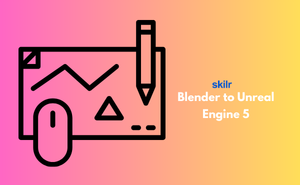👇 CELEBRATE CLOUD SECURITY DAY 👇
00
HOURS
00
MINUTES
00
SECONDS

Industry-endorsed certificates to strengthen your career profile.
Start learning immediately with digital materials, no delays.
Practice until you’re fully confident, at no additional charge.
Study anytime, anywhere, on laptop, tablet, or smartphone.
Courses and practice exams developed by qualified professionals.
Support available round the clock whenever you need help.
Easy-to-follow content with practice exams and assessments.
Join a global community of professionals advancing their skills.
Professionals need a solid understanding of 3D modeling, UV mapping, texturing, and rendering in Blender. They should also be familiar with asset optimization, exporting techniques, and Unreal Engine 5's tools, such as material creation, lighting, and landscape editing, to integrate Blender assets seamlessly into game environments or virtual productions.
Key roles include 3D Artist, Game Environment Designer, Level Designer, Technical Artist, and Virtual Production Specialist. These roles involve creating realistic assets, designing immersive environments, and optimizing workflows for real-time rendering applications.
Blender and Unreal Engine 5 are highly sought-after tools in industries like gaming, virtual reality, architecture, and film. Professionals skilled in both platforms can work on asset creation, level design, and cinematic production, providing diverse opportunities in creative and technical roles.
Industries like gaming, film production, architecture, and advertising heavily rely on professionals adept in Blender and Unreal Engine 5. The demand is particularly high in game development studios, VFX houses, virtual reality startups, and architectural visualization firms.
The market is moving towards real-time rendering and photorealistic visuals, driven by advancements in Unreal Engine 5. With Blender’s robust modeling tools and UE5’s real-time capabilities, professionals can create high-quality assets and environments faster, aligning with the increasing demand for immersive experiences.
Common challenges include understanding asset optimization, managing polygon counts, ensuring proper UV unwrapping, and learning Unreal Engine 5’s material and lighting systems. Overcoming these requires practice and a strong grasp of technical workflows.
Yes, freelance opportunities are abundant for those skilled in Blender and Unreal Engine 5. Projects include creating game-ready assets, designing architectural visualizations, and producing animated content. These platforms enable freelancers to deliver high-quality outputs efficiently.
Nanite and Lumen revolutionize real-time rendering, allowing for highly detailed models and dynamic lighting. This innovation increases demand for professionals who can create optimized, high-quality assets in Blender and integrate them seamlessly into UE5 for realistic results.
Comprehensive online courses, official documentation, and community forums provide excellent resources.
Blender to UE5 workflows enable game developers to create optimized, visually stunning assets while maintaining performance. This integration supports real-time rendering, modular asset design, and seamless pipeline transitions, making it essential for efficient game production.